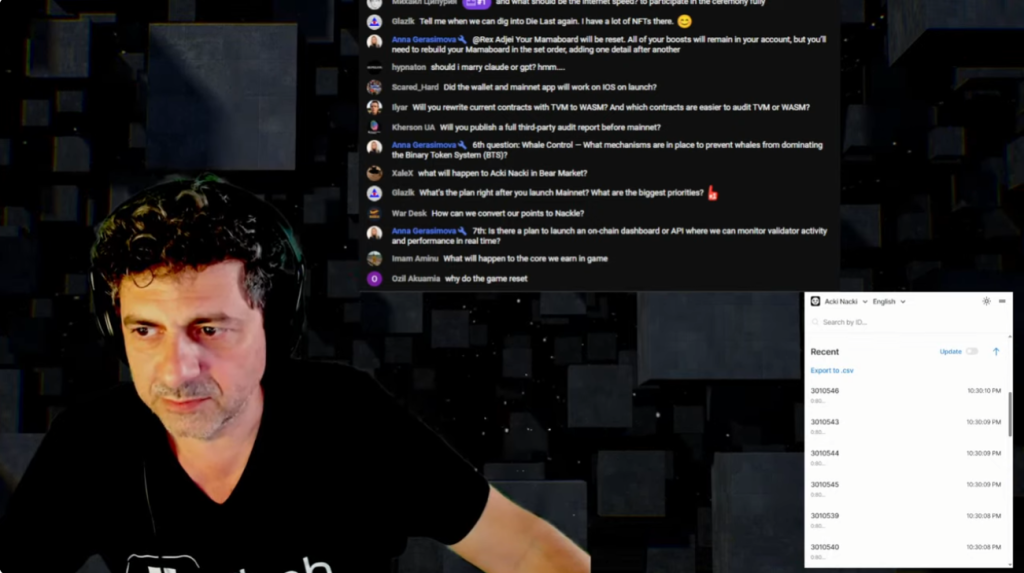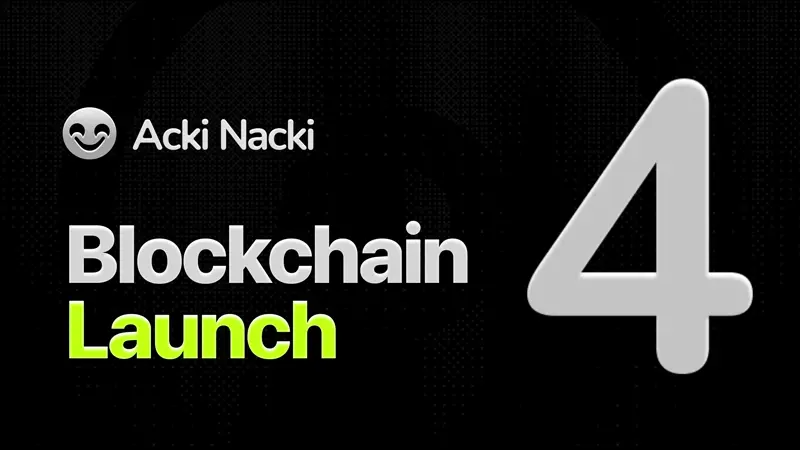AMA (Ask me Anything or better Ask Mitja Anything) has bee life streamed on 10. septempter 2025.
Mainnet is described as “days away,” with a working target of mid next week from the recording, pending final checks. Tokenomics and reward formulas remain as published; mining starts day 1 via Popit creation with boosts as the core multiplier.
Audio version/podcast style (mp3) you can listen/download here:
TLDR:
Mainnet is days away, targeting mid next week; pre-net proved live patching and external Block Keeper onboarding, day one includes Popit creation mining, major wallets, and a new explorer, with the bridge and DEX following soon after.
Tokenomics are unchanged, rewards are probabilistic and boosted by activity and hardware, Shell is the gas, supply targets 10.4B for one-per-human psychology, expect a 2–3 month transitional control period with no listings, and broader mining paths plus partnerships to roll out post-launch.
Video Transcript:
Host and speaker: Mitja Goroshevsky
Hey guys, hope you hear me well.
Anyway, good evening everyone. I’ll take questions about the Acki Nacki mainnet launch today.
Let’s see how it’s going.
I know we have a lot of questions, so I’ll try to answer them all. I don’t know how long it will take.
But let’s apply common sense. People say the sound is not loud enough, so I’ll try to fix it. I guess now it’s better, I hope. If not, I have no idea what else to do because I changed the sound system. There’s a limit to what I can do with this system yet, but I hope it’s good.
All right, let’s go then. Let’s start with the first question.
“At what date, and at what percentage-factor block licenses, do you seriously plan to launch?”
Mainnet. I guess at this stage it’s no longer about licenses. It’s more about final readiness. Basically, we are already there.
On the right-hand side of my screen you see the block explorer for the pre-net, and we crossed 3 million blocks a few minutes ago. You need to take into account that we stopped the pre-net for a good while. I think three days even, on Sunday, and what was it… two days ago, I think.
That was for some technical work we wanted to do on the pre-net. Exercises. Some things broke and we wanted to fix them without relaunching the network, because the purpose is to know how to do that on mainnet as well, in live settings, more or less.
So we patched the nodes. We restarted the nodes. We made the network available for external Block Keepers from around the world. Of course, they incurred several technical issues with managing the nodes and things like that, but it’s mostly on the DevOps side.
There are a few things we still want to add technically, like things for better protection or upgradability of the network, following these kinds of things we did on the pre-net. So in terms of when, it’s not down to a percentage of the block. All the Block Keepers needed for the network start are there. We’re not waiting for anyone.
There was one, the Forhash was starting to… there was an issue with the internet connection in its US data center, but it’s all fixed now. He’s still in the installation phase on some of his servers, but that’s not holding us up.
These are small things. I think we are very close. Basically, we’re days away. Realistically, I think something like mid next week we’re going to launch. That’s my best prediction. Again, don’t hold me accountable for that, but things look like that.
We thought maybe Friday, as usual. But the Friday after tomorrow, I don’t think we’ll be able to test all the things we changed. Sorry, my phone is buzzing.
So, yeah, realistically, mid next week, that’s the target date at the moment. There are no major issues holding us up. Everything is finally coming together.
Let’s see.
Uh-huh, you guys are asking about subtitles and different languages. Listen, I could try to take questions in all the languages I speak, but that would be unfair to everyone else, I guess. So let’s stick to English and we’ll add subtitles later on.
Second question: “How will Block Keeper rewards be calculated after mainnet launch? Exact formula.”
Well, you don’t expect me to give you the exact formula right now. There is a tokenomics paper. The exact formula is in there. Nothing changed from the tokenomics paper. It’s a probabilistic formula. It takes a lot into account. It takes…
(…continues; streamer references the tokenomics paper and the probabilistic calculation for rewards, reiterating that the formula hasn’t changed from the published tokenomics document, then returns to general Q&A.)
We did a lot of exercises on the pre-net. We made upgrades. We tested patching without relaunching. We opened the network to external Block Keepers. We restarted nodes. We verified that all of this can be done live so we can do it on mainnet too.
We also added some things for better protection and upgradability. There were a few DevOps issues with node management, but nothing serious. Most of it is organizational, not protocol problems.
Regarding licenses, it’s no longer about “license counts” for the launch. It’s final readiness. All Block Keepers needed for start are in place. Forhash had a connectivity issue in a US data center, but it’s fixed. Some servers are still being installed, but that’s not blocking launch. We’re very close.
Realistic timing: mid next week. We thought “Friday after tomorrow,” but we won’t have time to test everything we changed by then. So the target is mid next week. No major issues hold us up. Everything’s coming together.
About languages: we’ll keep the AMA in English now, add subtitles later.
Next: “How are Block Keeper rewards calculated after mainnet launch, exact formula?”
Again, see the tokenomics paper. The exact formula hasn’t changed. It’s probabilistic and takes many variables into account.
OK, going deeper. We patched nodes, restarted them, made the network available to external Block Keepers across the globe. They had various technical issues with managing nodes. Mostly DevOps. We also plan to add things for better protection and upgradability, following what we did on pre-net.
For timing: it’s not about a percentage of blocks. All the Block Keepers needed for the start are there. We’re not waiting for anyone. Forhash had an internet connection issue in a US data center. It’s fixed. Some servers are still being installed, not holding us up. We are very close. Days.
Realistically, mid next week we launch. Don’t hold me accountable for that exact day, but that’s the outlook. We thought about Friday, as usual. The Friday after tomorrow, we won’t be able to test everything we changed. Phone buzzing. So, realistic target: mid next week. No major blockers. Things are coming together.
Subtitles in different languages: we’ll add later. For now, English.
Second question again: “Block Keeper rewards after mainnet launch: exact formula?”
The formula is in the tokenomics paper. Nothing changed. It’s probabilistic and considers many factors.
(…brief repetition as the speaker checks sound, chat, and repeats core points to new joiners.)
People ask, “Can you take questions in all the languages you speak?” It wouldn’t be fair. We’ll stick to English and add subtitles.
Another question: “Will rewards change if we adjust license counts?” When we changed license counts back in June, it took a long time because validators demanded thorough checks. We had to verify everything. That’s why it took long to change license counts in June.
What else… You ask, “Are there plans to change anything on-chain in the first weeks?” We don’t plan to alter the fundamentals. If we need to do something, we’ll do it via patching, not relaunching. That was the point of the pre-net exercises.
“Could there be a fork?” Technically, anyone can try to fork. But there’s no practical path for a competing fork to become the “same network,” because of the way the participants, Block Keepers, verifiers, and managers are coordinated. To hard fork, you’d need to coordinate a lot. In Ethereum’s history, you ended up with Ethereum Classic and Ethereum, two separate networks. Which one is “the same”? It’s a philosophical question. In practice, a fork that doesn’t carry the economic majority and the operators won’t be the same network.
“Open source vs closed?” We’re strong believers in open source. The best projects in the world are open source. Open source accelerates adoption, security review, and community growth. That said, open source doesn’t remove the need for expertise. Teaching and fine-tuning models is hard. Inception is the problem, not teaching. If the base model is open, the rest is manageable.
“Mobile verifiers: three categories and big differences in rewards. Why such a gap? Won’t people in the lowest category play?” You can’t demand two things at the same time. One, that everyone gets a lot. Two, that whatever they get has value. If everyone gets the same rewards regardless of contribution, no one creates value. It’s self-defeating. If you’re doing something, you get boosts and move into a higher category. If you’re not doing anything, how do you expect to mine? We know what such systems create: nothing. You need to create value. You can’t demand that everyone gets a lot, and that what they get still holds value. That’s why socialism destroys every economy it touches.
You cannot do otherwise.
Like, you can. We created boost systems, and boosts, everyone can have the boosts. The only thing differentiating between these three groups are boosts.
You’re not buying boosts. Well, you can technically, before the network launch, you can buy a core and it will give you some boosts. That ends on Friday, by the way.
But you can go and earn boosts. Having more boosts will put you in the higher category. It’s up to you.
But when you say, “Oh, because we need boosts, we will not be able to mine in the first or second category because we don’t want to do anything, and to earn boosts, then… do we really need these people to play if they don’t want to do anything?” Like, it’s a self-defeating argument. If you are doing something, then you will get boosts and then you will get into a higher category. But if you are not doing anything, right, how do you still want to mine a lot? Why? It’s just… really, like, we know what these kinds of systems create. Nothing. This kind of system creates zero, because you need to create value.
You cannot demand two things at the same time. One, that everyone will get a lot, and two, that whatever they get will have value. That’s why socialism destroys every economy it touches. Sooner or later you will see what will happen to Spain. Okay, that’s like… intelligence? Maybe it already exists?
Ilya, I need this question rephrased, because I’m not married to any artificial intelligence. And so I’m not planning to be divorced. Okay, from her.
We’re currently experiencing some technical issues when sending rewards to users who registered for the email. Okay, so Anna is answering your question about the rewards.
What? You will be divorced? Really? You will be divorced in your project of official intelligence? Ilya, I need this question rephrased. I’m not married to any artificial intelligence.
A few questions: after mainnet starts, what are further plans for development on Acki Nacki? We’re not doing roadmaps, but yeah, I will do some projections during this stream that we’re going to collect afterwards and post separately. I think these projections kind of answer your question in a way. One of these projections is about the DEX. So the DEX is in work. The bridge is ready, like it’s ready. It just won’t be deployed on the first day, but quite soon after that.
MetaMask, OKX, Trust, and everything else will be ready at launch. Wallets, standard stuff.
About the bridge, again, it’s ready, but not day one. Soon after.
Homomorphic encryption. People ask about quantum resistance. Homomorphic encryption is interesting. It’s quantum-resistant. It’s just too slow at the moment. But yeah, we are thinking about that, and we’re actually doing something in that respect. It’s not for quantum computers at the moment. It’s just that there are other applications for homomorphic encryption and other such decryption… encryption schemes and, you know, cryptographic schemes basically, that we can use in different applications. By the way, they are also quantum… When will the explorer work?
I can’t put it under… on the explorer. Yeah, you cannot… like the explorer… People asking, what about the explorer?
I explained that, I think, and I can repeat. The explorer that we have right now, it’s just the developer kind of version. It’s not really this one. And then this one, the one that we have here… let me refresh, by the way. So this explorer is like developer… And we have a new one which is done. I think it’s done. And we’ll deploy it to do, like, the main explorer. So don’t worry about that. You will have a proper explorer.
Where will NACKL be sent to users who own cores? By the end of the year, because what you do with the cores… Basically, core is a fraction of ownership of the node which Gosh runs. And Gosh basically rents you the node capability for the year, and at the end of the year you’ll get your NACKLs for core. Unless you would want to continue.
When will Assemble Mama Board… while it’s set up open? And when will the… on bottom work? Assemble Mama Board will happen when the main starts. The second question I didn’t get. It’s jumping. The chat is jumping, so it’s hard to get.
I have a Block Keeper license delegated, but it’s not assigned now with the node. Assignment to node starts only when the mainnet starts. Is that right? When they start the node… yes, assignment to node starts with mainnet. That’s correct.
A symbol Mama Board will happen when main starts. The second question I didn’t get, the chat is jumping.
We’re thinking about formal verification, by the way. Moving system contracts to WASM. A lot of things we want to kill with that development as well, like state trading, like that. So, yeah, a few months. But would we be rewriting all the system contracts to WASM? I can dance with this now. That one, maybe yes, maybe not. With control… oh, how hard is the formal application from the formal notification? From the formal notification state, it’s not… it’s like the same, but there are tools which… a lot of these tools work for…
We’re in formal verification on a lot of it. More than a year already. It’s very hard, because parts are still changing. That’s partly why. Just to audit that would be hell.
“Will mining start this year?” Probably someone who came late. Rewatch the stream from the beginning.
“Tell me the details, how to create your own deck for the Popit game, and also how it can be used, or what could be the motivation to do this.”
I think we’re not going to answer this now, because it’s too detailed, and many people already know how.
“How is the team planning to push the marketing side of the NACKL token? Is there an actual plan behind it?”
We don’t push NACKL tokens. We push products. We push projects. We push games. We push integrations with companies. That’s what we push. We don’t push NACKL. I don’t know how to “push” NACKL. We push mining. That doesn’t push NACKL. Do we push money? Yeah, sure. I mean, how did we get like five million registered users? They just arrived. Obviously there is a marketing side. We’re doing marketing for the products we release. We market them. We try. Not everything is successful, but we try.
What’s pretty successful? I think we can and should do more. Yes, we will do more. There are things that are going to be released. For example, the Acki Nacki animated series. We’re working on it. You will see something from that when mainnet launches, on the day mainnet launches. It will be important.
“How will listings work?”
I have no idea. I don’t know how it will be listed. Should I care? Why should we care? Because you want to sell NACKL? I don’t. Not planning to. Ever. I’m not going to sell my NACKL tokens. Ever. Why should I care?
Just listening to your replies and various questions. I must say it’s interesting. Good to hear from you. Thank you. Thank you.
“Is 22 million a lot or small?” Compared to what? To 200,000? Then it’s 10 times more, 100 times more, whatever. Does that matter? What matters is the total value. How much you divide it by is just a unit of account. Why did we choose 10.4 billion? Maybe that’s the right question.
The answer: because in about 60 years there will be roughly 10.4 billion people on this planet. We wanted everyone to be able to have at least one NACKL. So no one would say, like with Bitcoin, “I cannot have a Bitcoin.” If there were 10.4 billion bitcoins today, everyone could say, “I can own one bitcoin.” It’s psychological. It’s not price or math. We want everyone to be able to have one NACKL in 60 years.
“How exactly will Popits be connected to mainnet mining? Will it generate NACKL, or will it just influence staking and mining rewards?”
Not sure I fully get the question. You mine by tapping Popits. You tap Popits. Depending on your Mama Board and your boosts, you get rewards. Everything we do will be on-chain. One hundred percent.
Will some Popits be rarer? I don’t know, it’s up to you. It depends on what Popcorn, sorry, Popit, you mint and what you do. If you’re an artist and you created several Popits and then you stop the collection, then it becomes rare.
“Are there planned external partnerships or collaborations to increase Popit user engagement?”
Definitely. We are talking to many partners. Collaborations are coming like a goulash, but it’s not necessarily connected only to Popits, it’s connected to the technology we’re building.
“What else will Acki Nacki provide to token owners? What makes Acki Nacki special?”
Don’t you know what makes Acki Nacki special? Acki Nacki is the fastest blockchain possible. It’s a chain where you can run non-financial computations the way you run them on normal cloud computers.
“Unlocking: can I unlock only a fraction?”
The amount of coins you want to unlock, that’s a great question. The answer is in tokenomics. When you stop mining Bitcoin you cannot sell 20 percent of your miner. You need to stop it all, then sell it. I know it’s not one-to-one, not the same thing, but think about the economics the same way.
We want to put you in a dilemma. Either you go out completely and start from zero, or you continue. Not the middle. You are all in, or you go away. That’s the mental framework we believe is right for participation. You cannot have a boyfriend and then another boyfriend half-time. You can, of course, but that’s not commitment.
History: NeXT. Steve Jobs built NeXT computers. Painfully slow. Hardware wasn’t there. He couldn’t make NeXT win. A few years later, after Apple sold off their old hardware business, they brought NeXTStep back as macOS. Same system ideas, but this time the hardware was ready. Suddenly, boom, it worked. The only difference was the hardware. We’re in the technology business. Without the speed of GPUs today, we would not have AI. It wouldn’t have happened.
“Layer 2s versus L1s?” Many L2s will die because of chains like Acki Nacki, or Solana. But Solana is not scalable enough, so now they talk about Layer 2 on Solana. They say, “No, no, it’s not Layer 2.” It is Layer 2, because Solana cannot scale further for all workloads. It’s fast, but it does not scale horizontally the way we need. Think of that like a tiny chip that can run only one program at a time, very fast, but still one program. Is it better than the old slow chip? Yes. Is it what we need? No.
“Will Shell be used as gas for NACKL transfers?”
Yes.
On institutions: we’ve worked with large organizations these last four years. One example, we ran a trial with them in a DAO, and at first I thought it didn’t work. That led us to create B-Engine, a governance model I think is genuinely novel. We will promote it inside that institution as well and see what happens when listings are… When are you ready to be rich? How about that answer. Come back when you are ready to be rich.
“Will you do anything to get you talking to the U.S. Reserve Fund? Is that an important goal?” I don’t think it’s a goal at all. A goal of who? If we are successful in Acki Nacki development, it would be stupid not to have it as an asset… but that’s not the current goal.
“Will other games be able to mine NACKL?”
Yes. Chess too. B-Engine will make it possible for playing other games, or other activities, to mine. What will not change are boosts. Boosts are the mining multiplier. Nobody will be able to give you more boost than the system allows. The mining system will not change over time. No. The ways you can mine will change, but you will still need boosts.
“How will early testers and printed [pre-net?] participants be rewarded?”
Come on. Please don’t repeat this question anymore. This is the third time. I don’t think anyone could… Next.
“You don’t need to play the card game?”
You can play Popits. You need to do something. You cannot just sit on your chair. Well, you can, if you buy a core. Then sit on the chair and do nothing. The core is fractional ownership of a Block Keeper license. Gosh runs the node for you. Other than that, you need to participate. If you don’t participate, you don’t provide value. Why would you get gains? It’s very simple. You do, you gain. You don’t do, you don’t gain.
“How can you prove to the SEC, for example, that your project is truly decentralized and that the Gosh company has no control over its operations?”
First, I hope not to prove anything to the SEC, ever. Second, at the moment I cannot prove that, because the network is not started yet. When the network starts, there will be a transitional period. We will still control some things. I believe for two to three months after mainnet we will still have some control. During these three months, no listing will happen. I would be very surprised if there were listings then.
“Is it unfair that a cores for eleven dollars gives less than a license owner who paid thousands?”
Please tell me what you mean by fairness. Is it “socialistic fairness,” where you divide the total by the number of participants? Is that fair? No. It is not fair to go and live in someone else’s apartment. It is not fair to give everyone the same share just because their blood is red. That’s my view. You can disagree. But you don’t get the same share without the same contribution.
“Mining system later?”
Exactly the same as today. Nothing changes, except you’ll be able to do more, with more hardware.
“Aren’t you mentally tired of answering hundreds of questions?”
If we talk about how tired I am, I don’t know, it’s beyond recognition of tiredness, so I can go like this forever.
“Will there be no mining for mobile verification at network launch, because Popit creation won’t be integrated until a few weeks later?”
No, no, no. Popit creation will be from day one. The Popit game will come later. You mine with Popits from the beginning.
“What is crypto-anarchism? How do you understand it, and how is it implemented in everyday life?”
Oh my god… category. Quick answer later.
On clearing blocks: if you have a lot of boosts, that mitigates. If you can’t clear a lot of blocks, boosts help. Of course, having more boosts and clearing more blocks gives more rewards. But it doesn’t mean you won’t be able to mine.
All right, guys, I think I’m done. I need to drink a lot of water now. Or tea, in my case.
Yes, I actually shared a lot of spoilers.
- B-Engine.
- Some predictions for five to ten years.
- Mainnet starts next week.
I did a lot of that. All right.
Thank you very much. Appreciate that. See you around, guys. Thanks a lot for being with us today.
Structured Brief
What changed (from the AMA)
- Go-live posture: Launch readiness is no longer tied to license percentages, it’s a pure technical go/no-go; target mid next week from recording, after extra testing.
- Pre-net results: Live patching, node restarts, and external Block Keeper onboarding were exercised, including recovery from a US data-center connectivity issue; pre-net passed ~3M blocks at the time of recording.
- Day-1 scope: Wallets (MetaMask, OKX, Trust, others) ready; Popit creation mining from day 1; bridge ready but not deployed on day 1; new production explorer to replace the dev build soon.
- Post-launch governance: Expect a 2–3 month transitional period with some centralized controls; listings are not expected during this window.
- Ecosystem signals: DEX under active development, animated series preview planned for launch day; Shell used as gas for NACKL transfers.
How it works (one paragraph)
Participants mine by creating and interacting with Popits, with rewards determined by a probabilistic formula in tokenomics that weights contribution and is multiplied by boosts and hardware, including the Mama Board profile. The network team validated live upgradability on pre-net by patching and restarting nodes without relaunch, then opening to external Block Keepers to surface DevOps issues. Governance will evolve through the proposed B-Engine model after mainnet, while core economic constants like boost multipliers are intended to stay stable even as new mining activities are added. Shell is the gas for transfers; a production explorer replaces the dev version; bridge deploys shortly after launch; DEX follows.
Counterpoints
- Schedule risk: “Mid next week” is a soft target with ongoing changes; last-mile testing or infra issues could slip dates.
- Utility gap on day 1: Bridge not deploying on launch day may limit initial liquidity and integrations.
- Incentive stratification: Boost-tiered rewards may concentrate gains among high-boost or core holders, potentially dampening casual participation.
- Decentralization lag: A 2–3 month transitional control period delays full decentralization and keeps listings off the table short-term.
So what for builders (concrete actions)
- Ship for day-1 realities: Integrate wallets now, design without assuming bridge availability on day 1, and plan for explorer API changes.
- Model rewards correctly: Implement the probabilistic reward math from tokenomics and expose boost effects in-app so users see cause and effect.
- Operational readiness: Stand up monitoring, alerting, and rollback paths for nodes, mirroring the pre-net patch-without-relaunch approach.
Unknowns and falsifiers
- Exact launch date: Not specified in the transcript; confirm with the canonical release notice. Falsifier: an announced delay or early launch.
- Bridge/DEX timelines: “Soon after” is vague; confirm deployment tags or changelogs. Falsifier: published release dates or repos.
- Mining invariants: Team states boost multipliers won’t change; watch for tokenomics amendments. Falsifier: a new tokenomics revision.
- Governance path: B-Engine details remain high-level; look for specs or audits. Falsifier: public spec differing from AMA claims.
- Performance under load: Pre-net results are promising, but mainnet traffic is unknown. Falsifier: observed throughput/latency diverging from claims.





